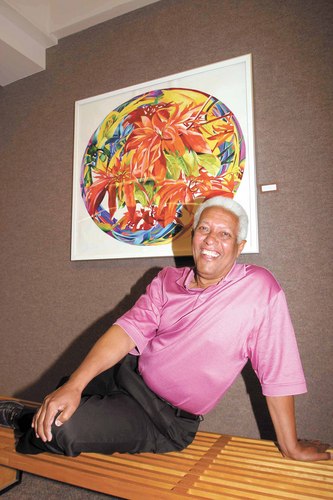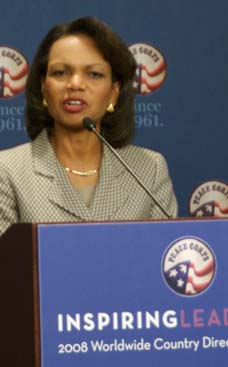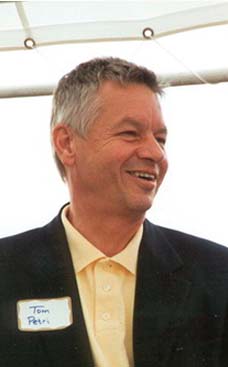
A couple of the Peace Corps volunteers, who hailed from Mesa, asked Pereira if he’d like to come to the U.S. and then offered to be his sponsor, giving him the opportunity to study whatever he’d like to pursue. He decided on art. “I lived with them for four years. During my first semester, I received four As and one B, so Arizona State University gave me a scholarship, retroactive. They asked if I wanted a check or cash. I told them, ‘Cash. I want to see the green.’” Pereira returned that tuition money to his sponsors and earned a bachelor’s degree and eventually a master’s degree in studio art. He taught for one year at a community college before accepting a position as a teacher in a magnet visual arts program at Phoenix High School. “Can I brag about my students?” Pereira asked. “In my 16 years teaching there, I’ve had four students graduate from the Art Institute of Chicago. … I also had a couple of students graduate from New York University and ASU.” Teaching doesn’t leave Pereira much time for his own artwork, so he fits in an hour or two with the paintbrush whenever and wherever he can. He chooses to work in watercolor, which he calls a “very tricky” discipline. “The general belief is that you can’t make mistakes. That’s not quite accurate. You don’t want to make mistakes. It’s the challenge,” that’s attractive about the medium, Pereira explained. “It’s like walking a tightrope with no safety net underneath. You have to be so focused. You can’t have weak knees, that’s for sure.”
Artist Sebastiao Pereira taught Portuguese to Peace Corps volunteers for three years
Brazil native’s love of art leads to life of teaching
Beth Rickers Worthington Daily Globe
Published Friday, July 11, 2008
Caption: Artist Sebastiao Pereira poses with one of his paintings currently on display at the Nobles County Art Center, 407 12th St., Worthington. (Beth Rickers/Daily Globe)
WORTHINGTON — During the short time he’s been in this part of the country, Sebastiao Pereira has encountered a tornado, delivered meals to shut-ins, picked strawberries and completed two paintings. Except for the painting, those were fresh experiences for Pereira, a native of Brazil who now lives in Phoenix, Ariz.
Traveling to Worthington offered a respite from the intense summer heat of Arizona, as well as a new audience for Pereira’s vibrant watercolor creations, which are currently on display at the Nobles County Art Center. The exhibit was facilitated by local resident Elden Ponto, who spends winters in Mesa, Ariz.
“We met through friends at parties last winter,” Ponto related. “I became interested in his artwork. When I saw his paintings, I realized, with the vibrant colors, how very different they were from the usual watercolors you see. Then he invited me to one of his artistic critique sessions … and I realized the value of his artwork and his humor besides.”
Hailing from a rural area in the state of Minas Gerais in the central part of Brazil, adjacent to Rio de Janeiro, Pereira remembers his earliest encounter with an artistic endeavor.
“When I was 6 years of age, my sister made a drawing book for me, a sketch pad,” he said. “She drew in the Brazilian maps, maps of other countries and the Brazilian flag. I immediately took possession. That was MY sketch book.
“My parents were both artists, although it took me a while to recognize the fact they were artists,” he continued. “They were weavers. My mother wove blankets; my father wove baskets and also the ceilings of my house. I remember spending hours as a child, looking up at the ceiling, at how the patterns were put together.”
At age 14, Pereira signed up for an art course via correspondence.
“Paying for the course was a struggle,” he recalled. “I carried vegetables in a big basket to the big city, in the wintertime, with no shoes on. It was miserable. Isn’t that a romantic story — the shoeless kid who comes to the United States.”
Pereira worked as a graphic designer in his home country and attended a college connected to a Catholic seminary with the thought of becoming a priest.
“My major was English and Portuguese as second languages, and I taught Portuguese to Peace Corps volunteers for three years. I even had a fancy title, something like Language Culture Technology Trainer,” he explained.
A couple of the Peace Corps volunteers, who hailed from Mesa, asked Pereira if he’d like to come to the U.S. and then offered to be his sponsor, giving him the opportunity to study whatever he’d like to pursue. He decided on art.
“I lived with them for four years. During my first semester, I received four As and one B, so Arizona State University gave me a scholarship, retroactive. They asked if I wanted a check or cash. I told them, ‘Cash. I want to see the green.’”
Pereira returned that tuition money to his sponsors and earned a bachelor’s degree and eventually a master’s degree in studio art. He taught for one year at a community college before accepting a position as a teacher in a magnet visual arts program at Phoenix High School.
“Can I brag about my students?” Pereira asked. “In my 16 years teaching there, I’ve had four students graduate from the Art Institute of Chicago. … I also had a couple of students graduate from New York University and ASU.”
Teaching doesn’t leave Pereira much time for his own artwork, so he fits in an hour or two with the paintbrush whenever and wherever he can. He chooses to work in watercolor, which he calls a “very tricky” discipline.
“The general belief is that you can’t make mistakes. That’s not quite accurate. You don’t want to make mistakes. It’s the challenge,” that’s attractive about the medium, Pereira explained. “It’s like walking a tightrope with no safety net underneath. You have to be so focused. You can’t have weak knees, that’s for sure.”
While watercolors are known for their transparent, often muted quality, Pereira's paintings are brilliantly colored, with the images jumping sharply off the canvas.
“That’s my Brazilian background — the bright colors, yellows, greens, reds,” he said. “I don’t paint to match somebody’s couch. … One of my other attractions to watercolor is that I love words, and the word for watercolor in Brazil is aquarela. It sounded like music to me.”
The subject matter of Pereira's paintings is diverse, with some images taken from nature — flowers in particular — but also a variety of found objects.
“They are objects I find at garage sales or around my studio. When I put them together, they tell a story I’m not even aware of sometimes.”
For instance, Pereira related a story about when he was 3 years old and his father took a scissors away from him. An argument ensued, and the relationship between father and son was always rocky. Later in life, Pereira began using scissors in his paintings, liking the diagonal effect they created. A student who was majoring in psychology noted that he was about to “pull the plug on someone” in one of his paintings — a scissor was poised to cut the cord of a coffee pot.
“I was unaware of the narrative until that time,” Pereira said. “My father was a big coffee drinker and would always say that if he knew there was no coffee to drink after meals, he’d rather go hungry. It was like I was saying to him, ‘I’ll get you. I’ll make sure you don’t have any coffee.’”
Not all of Pereira's paintings carry such a hidden message, however. He likes to play with light, how it reflects off objects and the contrast of light and dark.
“I’m also intrigued with fractos … it comes from the word fraction. … It’s the idea of taking the whole and fragmenting it. What I do is, with Photoshop, I dismantle a painting I’ve done previously, dismember the whole thing, and rearrange it. I’m also fascinated with the use of technology. The computer is another tool to work with. It allows me to have a new vision.”
Pereira's work will hang in the Nobles County Art Center through July 31. He’s also made contact with several other area galleries and hopes to schedule more exhibits for a return trip next year.
The opening reception for the Worthington exhibit will be from 2 to 4 p.m. Sunday in the art center gallery, located in the lower level of the War Memorial Building, 407 12th St. The gallery is open from 2 to 4:30 p.m. Monday through Friday. For more information, call 372-8245.









